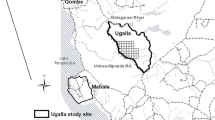Abstract
DNA “fingerprinting” using polymorphic (CA)-repeat microsatellite markers was used to quantify the level of genetic variation present in chimpanzees (Pan troglodytes) in the Australasian region. These markers were also used to determine the paternity of chimpanzees born at Taronga Zoo over a 20-year period. The results suggested that the dominant male in the colony was responsible for siring most, but not all, of the offspring. Where the dominant male was excluded from paternity, the sire was identifiable if all candidate males were available for typing. This enabled us to prove the captive origin of offspring born in the colony during this period. Thus, microsatellite analysis was a useful tool for assignment of familial relationships and improving genetic management of breeding colonies.
Similar content being viewed by others
References
Caslick, S. 1996. Australasian Regional Captive Management Plan for Chimpanzees (Pan troglodytes). Australasian Regional Association of Parks and Aquaria, Sydney.
Garza, J. C.;Slatkin, M.;Freimer, N. B. 1995. Microsatellite allele frequencies in humans and chimpanzees, with implications for constraints on allele size.Mol. Biol. Evol., 12: 594–603.
Groves, C. P.;Westwood, C.;Shea, B. T. 1992. Unfinished business: Mahalanobis and a clockwork orang.J. Human Evol., 22: 327–340.
Hill, W. C. O. 1969. The nomenclature, taxonomy and distribution of chimpanzees. In:The Chimpanzee,Bourne,G. H. (ed.), Karger, Basel, pp. 22–49.
Houlden, B. A.;England, P.;Sherwin, W. B. 1996. Paternity exclusion in koalas using hypervariable microsatellites.J. Heredity, 87: 149–152.
Lacy, R. 1994.Genes 11.50: Pedigree Analysis Software. Chicago Zoo Park, Chicago.
Lahiri, D. K.;Nurnberger, J. I., Jr. 1991. A rapid non-enzymatic method for the preparation of HMW DNA from blood for RFLP studies.Nucl. Acids Res., 19: 5444.
Morin, P. A.;Wallis, J.;Moore, J. J.;Chakraborty, R.;Woodruff, D. S. 1993. Non-invasive sampling and DNA amplification for paternity exclusion, community structure, and phylogeography in wild chimpanzees.Primates, 34: 347–356.
Pascali, V. L.;Bisol, G. D.;Dobosz, M.;D'Aloja, E. 1994. Chimpanzee DNA profiles on trial.Nature, 367: 692–693.
Scobie, P. 1994.Single Population Animal Records Keeping System (SPARKS) 1.3. International Species Information System, Minnesota.
Takenaka, O.;Takasaki, H.;Kawamoto, S.;Arakawa, M.;Takenaka, A. 1993a. Polymorphic microsatellite DNA amplification customized for chimpanzee paternity testing.Primates, 34: 27–35.
Takenaka, O.;Udono, T.;Arakawa, M.;Takasaki, H.;Takenaka, A. 1993b. Chimpanzee microsatellite PCR primers applied to paternity testing in a captive colony.Primates, 34: 357–363.
Thompson, D. M.;Brown, N. N.;Clague, A. E. 1992. Routine use of hair root or buccal swab specimens for PCR analysis: advantages over using blood.Clinica Chimica Acta, 207: 169–174.
Tomfohrde, J.;Wood, S.;Schertzer, M.;Wagner, M. J.;Wells, D. E.;Parrish, J.;Sadler, L. A.;Blanton, S. H.;Daiger, S. P.;Wang, Z.;Wilke, P. J.;Weber, J. L. 1992. Human chromosome 8 linkage map based on short tandem repeat polymorphisms: effect on genotyping errors.Genomics, 14: 144–152.
Weber, P. L.;May, P. E. 1989. Abundant class of human DNA polymorphism which can be typed using the polymerase chain reaction.Amer. J. Human Genet., 44: 388–396.
Weissenbach, J.;Gyapay, G.;Dib, C.;Vignal, A.;Morissette, J.;Millasseau, P.;Vaysseix, G.;Lathrop, M. 1992. A second-generation linkage map of the human genome.Nature, 359: 794–801.
Wilkie, P. J.;Krizman, D. B.;Weber, J. L. 1992. Linkage map of human chromosome 9 microsatellite polymorphisms.Genomics, 12: 607–609.
Author information
Authors and Affiliations
About this article
Cite this article
Houlden, B.A., Woodworth, L. & Humphrey, K. Captive breeding, paternity determination, and genetic variation in chimpanzees (Pan troglodytes) in the Australasian region. Primates 38, 341–347 (1997). https://doi.org/10.1007/BF02381621
Received:
Accepted:
Issue Date:
DOI: https://doi.org/10.1007/BF02381621



